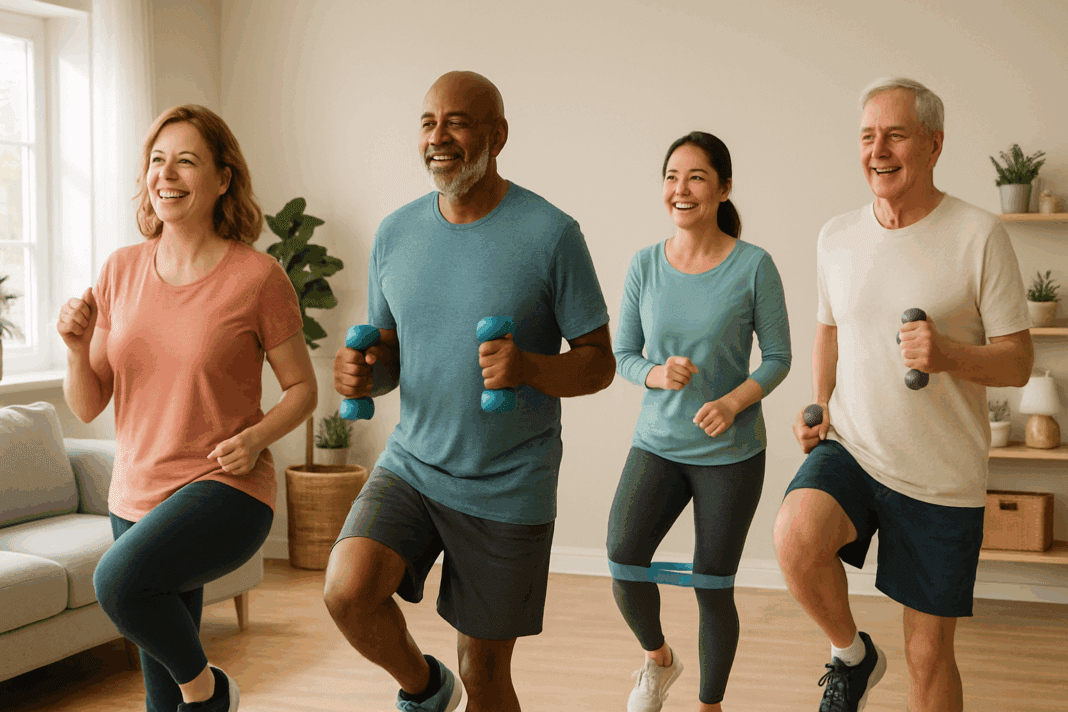For many individuals seeking to improve their health and fitness, finding the right kind of workout can feel overwhelming. Between high-intensity trends and complex gym regimens, those looking for a sustainable, joint-friendly, and time-efficient option may not know where to start. Yet for those navigating busy schedules or managing chronic conditions, the appeal of a 30 minute low impact cardio workout cannot be overstated. This type of routine offers a practical, gentle way to build cardiovascular endurance, improve mobility, and boost overall wellness without the physical toll of high-impact exercise. The science, accessibility, and versatility of these workouts make them an invaluable tool for achieving a healthier lifestyle, naturally and sustainably.
You may also like: How to Increase Stamina and Endurance Naturally: Smart Training Tips and Nutrition Habits That Support Cardiovascular Fitness

Understanding Low Impact Cardio: The Foundation of Functional Fitness
Low impact cardio is often misunderstood as being less effective or only suited for older adults. In reality, this form of exercise can be just as powerful as high-intensity alternatives—especially when consistency, safety, and longevity are priorities. The defining characteristic of a low impact workout is its minimal strain on the joints. Rather than movements that involve jumping or pounding, low impact routines include exercises where at least one foot remains on the ground at all times. This includes walking, elliptical training, step aerobics, swimming, and cycling, among others.
What distinguishes a 30 minute low impact cardio workout from other fitness formats is its intentional blend of intensity and gentleness. You still elevate your heart rate, encourage oxygen flow to muscles, and activate the cardiovascular system, but in a way that reduces wear and tear on ligaments and joints. For individuals recovering from injury, managing arthritis, or simply preferring a kinder workout modality, this balance is key. Additionally, such workouts are inherently scalable. Whether you’re a beginner or more advanced, you can adapt the pace, resistance, or complexity to suit your current abilities and goals.
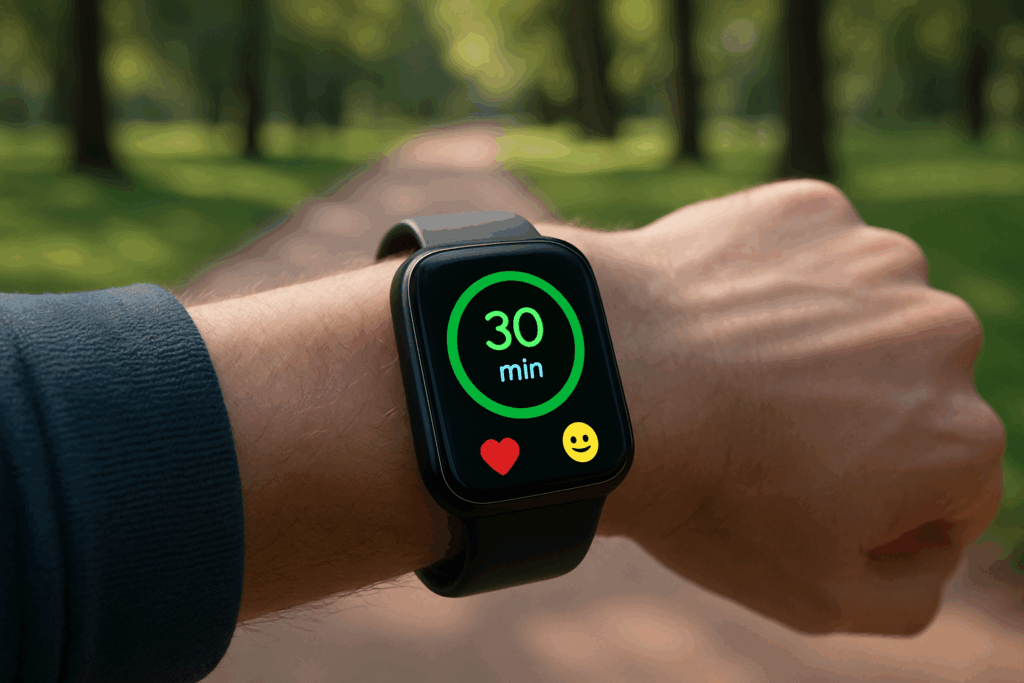
Why 30 Minutes Matters: The Science of Time-Efficient Movement
The choice to center workouts around the 30-minute mark is not arbitrary. Research in exercise physiology supports the idea that moderate-intensity cardiovascular activity performed for 30 minutes a day can significantly impact heart health, metabolic function, and even mood regulation. In fact, the World Health Organization recommends at least 150 minutes of moderate-intensity aerobic physical activity per week, which aligns perfectly with doing a 30 minute low impact workout five times weekly.
For those managing tight schedules, family responsibilities, or full-time jobs, a 30 minute low impact aerobic workout can be realistically integrated into the day without requiring major sacrifices. Unlike high-intensity training, which often demands lengthy recovery periods, low impact cardio can be performed daily without overwhelming the body. This allows for consistency, one of the most critical factors in achieving long-term fitness goals.
Furthermore, research from the American Heart Association shows that even shorter bouts of exercise, when accumulated throughout the day, offer similar benefits to a single continuous session. Still, dedicating a focused 30-minute block allows for mental presence, stress reduction, and the meditative qualities of rhythmic movement. It becomes not just a physical exercise, but a ritual of self-care that enhances mental clarity and emotional balance.

Cardiovascular Benefits Without the Burnout
One of the greatest advantages of incorporating a 30 minute low impact cardio workout into your routine is that it protects your body from burnout. Many people approach fitness with an all-or-nothing mindset, pushing themselves to extremes in the hope of quick results. However, high-impact or high-intensity routines often come with increased risk of overtraining, fatigue, and injury—especially when not properly supervised or progressed.
Low impact cardio, by contrast, offers a steady, sustainable approach to cardiovascular conditioning. Your heart and lungs still work efficiently, and over time, the cumulative benefits include lowered blood pressure, improved circulation, and enhanced aerobic capacity. Moreover, consistent aerobic activity supports the body’s ability to regulate blood sugar and cholesterol levels, reducing the risk of chronic diseases like type 2 diabetes and cardiovascular disease.
By choosing a 30 min low impact cardio workout over an aggressive high-impact session, you’re prioritizing long-term wellness over short-term exertion. This mindset not only promotes physical health but encourages a healthier relationship with movement—one that is rooted in care, consistency, and respect for the body’s needs.
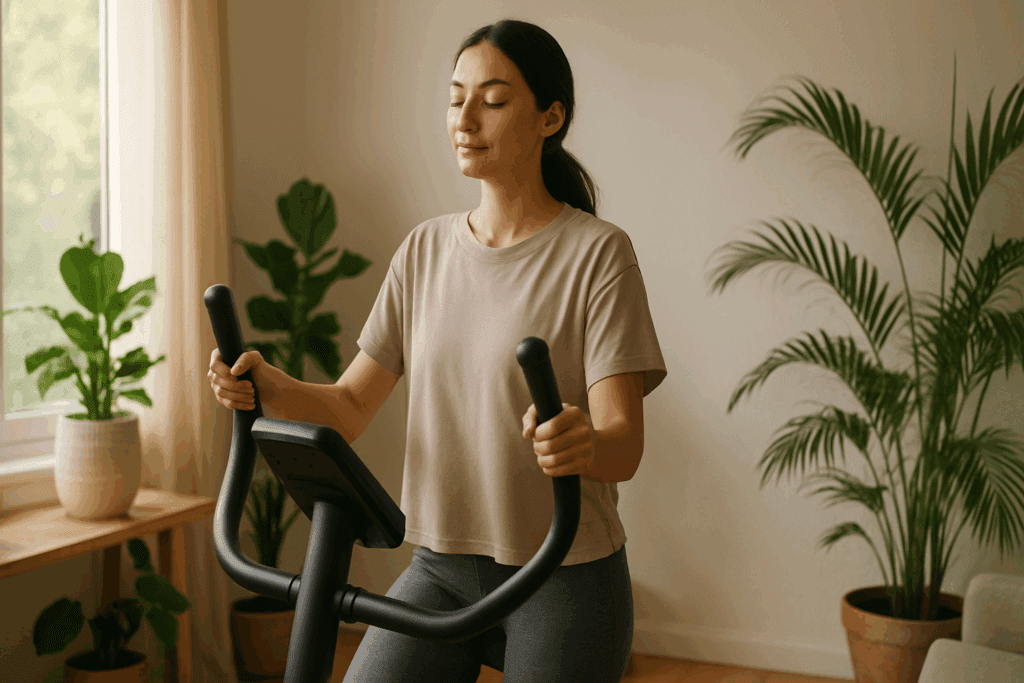
Metabolic Support and Weight Management
While high-intensity workouts are often touted as the gold standard for fat loss, they’re not the only effective strategy for supporting a healthy metabolism. A well-designed 30 min low impact cardio session can stimulate fat oxidation, improve insulin sensitivity, and increase caloric expenditure—all without pushing the body to its limits. Because low impact cardio can be sustained for longer periods with lower perceived exertion, it encourages adherence and reduces the likelihood of exercise dropout.
This type of movement is particularly beneficial for those experiencing metabolic disorders, thyroid dysfunction, or hormonal imbalances, where overly intense training may worsen symptoms. A 30 minute low impact cardio workout performed consistently can create a modest calorie deficit while preserving muscle mass and maintaining energy levels. Over time, this leads to gradual, sustainable weight loss or weight maintenance, depending on one’s goals.
Moreover, combining this routine with mindful eating habits enhances its effectiveness. When paired with whole foods, proper hydration, and a balanced approach to nutrition, low impact cardio serves as a powerful complement to metabolic health. It helps regulate appetite hormones such as leptin and ghrelin, encourages regular bowel movements, and supports the detoxification pathways—all of which contribute to a healthier lifestyle naturally.
Mental Health Benefits and Cognitive Support
The psychological impact of physical activity is widely documented, but the unique benefits of low impact cardio in supporting mental wellness often go underappreciated. Engaging in a daily 30 minute low impact workout helps release endorphins—commonly known as feel-good hormones—which contribute to a sense of calm and elevated mood. Because low impact fitness emphasizes rhythm, breathing, and sustained motion, it doubles as a form of moving meditation.
Studies in neuroscience suggest that regular aerobic activity, even at moderate intensities, can increase the size of the hippocampus, the brain region associated with memory and learning. In this context, low impact cardio doesn’t just support emotional resilience but enhances cognitive function, focus, and creativity. These outcomes are particularly valuable in a world saturated with stressors, digital distractions, and mental fatigue.
Low impact workouts also offer a unique opportunity to practice mindfulness. Unlike aggressive routines that demand full physical exertion, a 30 minute low impact cardio session allows space for introspection, breath awareness, and mind-body connection. For individuals managing anxiety, depression, or burnout, this type of movement can become a grounding, restorative practice that complements other holistic interventions such as therapy, nutrition, and sleep hygiene.
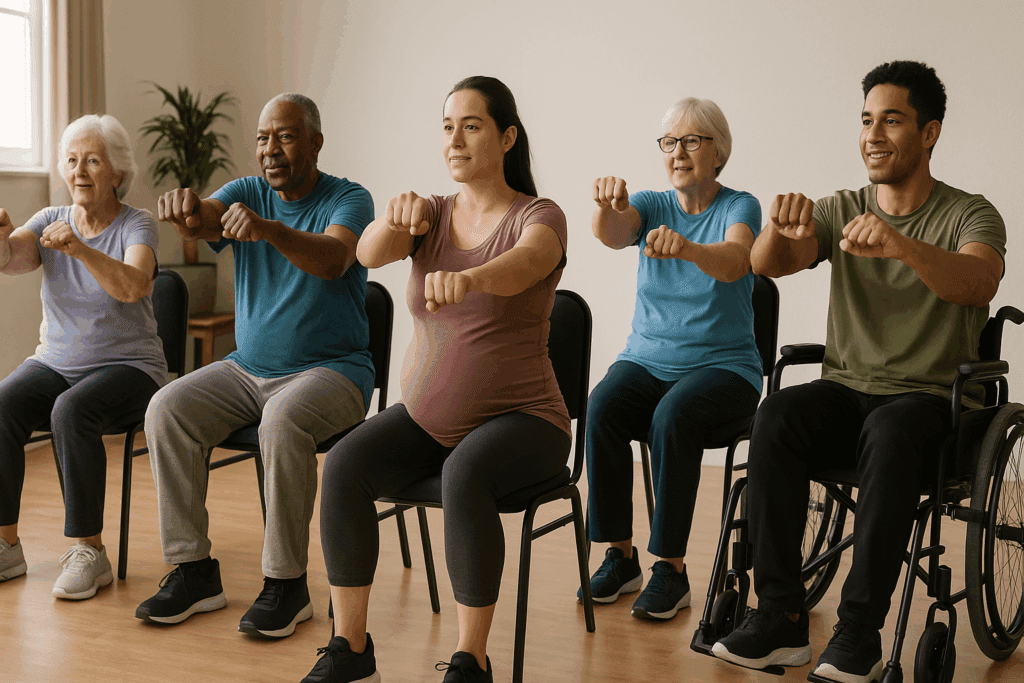
Accessibility and Inclusivity in Fitness
Another key strength of the 30 minute low impact cardio model lies in its accessibility. Because it requires little to no equipment and can be adapted to various skill levels, it opens the door for broader participation across ages, abilities, and backgrounds. Whether you’re using low impact fitness videos at home or following a structured gym plan, the options are virtually limitless.
This inclusivity makes low impact workouts particularly valuable in community health settings, senior care programs, and rehabilitation centers. They are often recommended for postpartum women, individuals with obesity, and people recovering from surgery or illness. With proper guidance, nearly anyone can benefit from these routines—regardless of prior experience or fitness level.
Low impact fitness videos have especially democratized access to high-quality instruction. With platforms offering on-demand classes led by certified trainers, users can find targeted routines that address specific needs, whether it’s flexibility, core stability, or cardiovascular conditioning. This level of personalization fosters autonomy, empowerment, and accountability, helping individuals stay engaged and motivated over the long term.
Practical Strategies to Make It a Habit
Turning a 30 minute low impact workout into a consistent habit requires more than good intentions—it demands structure, motivation, and a bit of creativity. One effective strategy is to treat your workout as a non-negotiable appointment. Block off time in your calendar, prepare your space, and set realistic expectations about what you hope to achieve in each session.
Start by identifying the time of day when your energy is highest or your schedule most flexible. Some people find early morning sessions energizing and meditative, while others prefer winding down with movement in the evening. Choose an environment that supports your efforts—whether it’s a quiet room, a scenic walking path, or a local fitness studio.
Integrate variety into your routine to avoid plateaus and boredom. Alternate between different low impact activities such as brisk walking, indoor cycling, or following a dance-based workout. Utilizing different low impact fitness videos throughout the week can provide fresh challenges while keeping the body engaged and responsive.
Set meaningful goals that go beyond aesthetics. Rather than focusing solely on weight loss, consider tracking your progress in terms of endurance, energy levels, or mood improvements. Celebrate small wins and reflect on how your 30 minute low impact cardio workout is enhancing not just your physical health, but your quality of life as a whole.
The Synergy of Movement and Nutrition
Movement and nutrition are two sides of the same wellness coin. Engaging in regular low impact exercise creates a physiological state that enhances the body’s ability to metabolize nutrients efficiently. After a 30 minute low impact cardio workout, the body is primed to absorb glucose into the muscles, replenish glycogen stores, and repair tissues using dietary protein.
This synergy is especially important for individuals navigating blood sugar fluctuations, digestive issues, or hormonal imbalances. A light, protein-rich meal combined with fiber and healthy fats after exercise can stabilize insulin response and promote muscle recovery. Similarly, staying hydrated and fueling with complex carbohydrates before a workout helps sustain energy and prevent fatigue.
Mindful eating practices complement this physical routine by encouraging slower, more intentional meals that improve digestion and satiety. When combined, a 30 min low impact cardio workout and a balanced nutrition strategy can work in tandem to promote long-term vitality, resilience, and metabolic harmony.
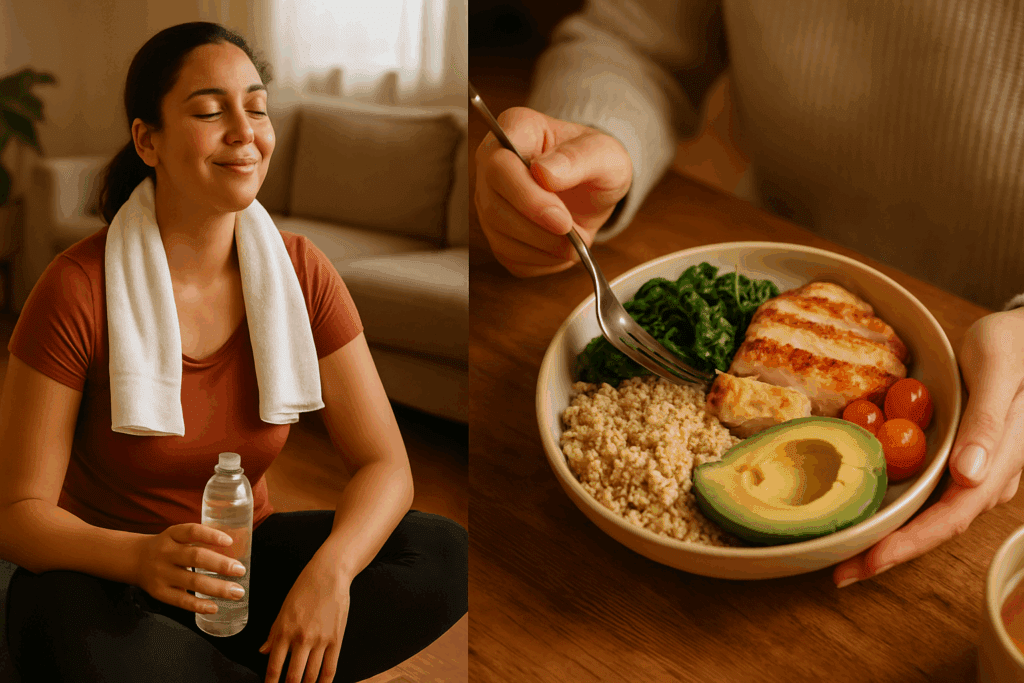
Redefining Fitness Through Sustainability and Joy
In a culture obsessed with quick fixes and dramatic transformations, low impact cardio offers a refreshing alternative grounded in sustainability and joy. Rather than chasing extreme outcomes, it invites individuals to move with intention, tune into their bodies, and prioritize wellness from the inside out.
A daily or near-daily 30 minute low impact aerobic workout becomes a form of self-respect. It teaches us to appreciate gradual progress, build self-efficacy, and reconnect with the innate pleasure of movement. For those who’ve been alienated by diet culture or high-pressure fitness environments, this approach provides a gentler, more compassionate path to health.
Low impact cardio also fosters intergenerational movement. Families can walk together, participate in gentle yoga, or explore low impact fitness videos suited for all ages. These shared experiences not only build physical health but strengthen relationships and emotional bonds, reinforcing the holistic nature of well-being.
Frequently Asked Questions: 30 Minute Low Impact Cardio Workouts
What are some creative ways to vary my 30 minute low impact cardio workout at home?
Variety is key to maintaining interest and maximizing the benefits of a 30 minute low impact cardio workout. Consider integrating themed days, such as “dance cardio” on Mondays using upbeat music or “mobility flow” Fridays that blend dynamic stretching with gentle aerobic movements. You can also explore seasonal or nature-inspired routines, like mimicking hiking motions or gardening tasks, which transform your space and mind. To further personalize your session, rotate between different low impact fitness videos from diverse instructors and platforms, which keeps things fresh and exposes you to new movement styles. Small equipment like resistance bands or light hand weights can also be incorporated without turning your session into high impact training, ensuring you preserve the integrity of a low impact structure.
Can a 30 min low impact cardio workout be beneficial for athletes during recovery phases?
Absolutely—active recovery is crucial for injury prevention and long-term performance, and a 30 min low impact cardio workout fits seamlessly into this strategy. During recovery phases, athletes often need to maintain cardiovascular endurance while minimizing joint strain or muscle overload. Low impact modalities like water aerobics, slow cycling, or elliptical training offer gentle stimulation of circulation and lymphatic drainage without creating undue fatigue. Incorporating these workouts into a recovery week helps speed up muscle repair and can also improve mobility. The reduced intensity allows the nervous system to recalibrate while still reinforcing neuromuscular patterns, keeping athletes engaged and resilient.
What role do low impact workouts play in managing hormonal health, especially in women?
A consistent 30 minute low impact aerobic workout can play a significant role in supporting hormonal balance, particularly for women dealing with PMS, menopause, or thyroid issues. Gentle cardio promotes the release of endorphins while helping regulate cortisol, the body’s primary stress hormone. Excessive high-intensity workouts can sometimes exacerbate adrenal fatigue or dysregulate estrogen and progesterone levels, making low impact exercise a safer long-term choice. This makes low impact cardio an excellent option during phases of hormonal fluctuation, when the body is more sensitive to physical and psychological stress. Moreover, pairing these routines with mindful breathing techniques amplifies their restorative effect on the endocrine system.
Is a 30 minute low impact cardio workout effective for improving posture and spinal health?
Yes, particularly when the routine includes movements that activate the posterior chain and core stabilizers. Many low impact exercises such as marching in place, step touches, or side lunges can be modified to engage muscles that support the spine. When done mindfully, a 30 min low impact cardio session can promote spinal alignment and reduce postural fatigue caused by prolonged sitting. Over time, consistent movement strengthens neuromuscular coordination between the back, glutes, and core—areas essential for upright posture. Additionally, many low impact fitness videos now incorporate posture-focused segments or guided alignment cues, making this benefit more accessible to home exercisers.
How do low impact fitness videos enhance the long-term sustainability of fitness routines?
Low impact fitness videos provide the structure, guidance, and accessibility that many people need to maintain consistency. They remove common barriers such as time constraints, gym intimidation, and lack of variety, making it easier to stick with a routine. Many platforms offer programs specifically designed around 30 minute low impact cardio workouts, allowing users to progress gradually and revisit favorites. Additionally, these videos often include motivational coaching or modifications, which fosters inclusivity and helps users feel seen and supported. When combined with community forums or virtual accountability groups, these digital tools make it more likely that individuals will stay committed for the long haul.
Can a 30 minute low impact cardio workout support lymphatic drainage and immune function?
Yes, regular rhythmic movement is essential for stimulating the lymphatic system, which relies on muscular contraction and movement for flow. A 30 minute low impact cardio session, especially one involving large muscle groups and fluid transitions, enhances this process naturally. This can help with toxin clearance, reduce inflammation, and potentially improve immune surveillance. Unlike more intense workouts that can temporarily suppress immune function, a moderate 30 minute low impact workout supports immunity without overtaxing the system. Activities such as rebounding on a mini trampoline or flowing step routines are especially effective in promoting lymph flow while keeping impact low.
How can people with limited mobility benefit from a 30 minute low impact aerobic workout?
There are numerous adaptations available for those with mobility restrictions, ensuring that everyone can engage in a meaningful 30 minute low impact aerobic workout. Chair-based routines are a popular option and can include upper-body cardio, resistance work, and flexibility training. Seated workouts featured in many low impact fitness videos often involve creative sequencing that challenges coordination and cardiovascular endurance without requiring standing. For individuals with joint conditions or balance concerns, these sessions can offer the same benefits—such as improved circulation, better respiratory function, and reduced muscle stiffness—as traditional formats. By prioritizing accessibility, these workouts empower more people to participate in wellness without fear of injury or overexertion.
How do 30 min low impact cardio workouts influence sleep quality?
Low impact cardio has a powerful effect on sleep, particularly when timed strategically during the day. A 30 min low impact cardio workout performed in the late afternoon or early evening can help regulate circadian rhythms and promote deeper sleep onset. Unlike high-intensity training that may elevate cortisol and interfere with rest, low impact routines support the parasympathetic nervous system—helping you wind down more effectively. This benefit becomes more pronounced when the workout includes elements of rhythmic breathing or is followed by a relaxing cooldown. Consistency is key; regular movement helps reduce sleep latency and increases time spent in restorative stages of sleep, especially for individuals with insomnia or stress-related sleep disruptions.
Are there psychological or behavioral benefits unique to doing low impact cardio in short daily sessions?
Yes, integrating a daily 30 minute low impact workout into your routine can help build psychological resilience and support habit formation. Unlike sporadic, intense training schedules, daily low impact cardio helps foster a reliable routine, which can reduce decision fatigue and improve overall life structure. Over time, this predictability builds intrinsic motivation and a sense of accomplishment, reinforcing mental discipline. It can also help reduce all-or-nothing thinking often associated with exercise avoidance or guilt. The relatively low barrier to entry means you’re less likely to skip workouts, and that consistency nurtures self-trust—laying a foundation for other healthy lifestyle behaviors.
What emerging trends are shaping the future of 30 minute low impact cardio workouts?
The future of low impact cardio is being influenced by wearable tech, AI-driven customization, and hybrid fitness models that blend live coaching with on-demand flexibility. Many smart watches and fitness platforms now tailor suggestions based on biometrics, recommending low impact cardio sessions when recovery metrics are low. In addition, companies are producing immersive low impact fitness videos that incorporate virtual reality, making at-home workouts more engaging. Another growing trend is “movement snacking,” where multiple shorter bouts of low impact movement are spread throughout the day, collectively totaling a full 30 minute low impact cardio workout. These innovations are not only making fitness more accessible but are aligning with a broader shift toward personalized, sustainable wellness practices.
Conclusion: Embracing a Healthier Lifestyle with a 30 Minute Low Impact Cardio Workout
Adopting a 30 minute low impact cardio workout as part of your lifestyle is more than a fitness choice—it’s a declaration of commitment to your long-term well-being. It reflects a philosophy that values consistency over intensity, presence over performance, and progress over perfection. Whether you’re just beginning your fitness journey or returning after a hiatus, this approach offers a safe, sustainable, and deeply empowering path forward.
By integrating low impact movement with mindful eating and supportive routines, you’re crafting a lifestyle that honors your body, nurtures your mind, and aligns with your values. Thanks to the accessibility of low impact fitness videos, the flexibility of 30 min low impact cardio routines, and the wealth of evidence supporting their benefits, anyone can take that first step today. In doing so, you’re not just working out—you’re cultivating health, energy, and joy that will carry you through all stages of life.
Was this article helpful? Don’t let it stop with you. Share it right now with someone who needs to see it—whether it’s a friend, a colleague, or your whole network. And if staying ahead on this topic matters to you, subscribe to this publication for the most up-to-date information. You’ll get the latest insights delivered straight to you—no searching, no missing out.
Further Reading:
3 Kinds of Exercise That Boost Heart Health
Try This: 6 Low-Impact Cardio Exercises in 20 Minutes or Less
What Happens to Your Body When You Exercise 30 Minutes Every Day

